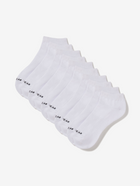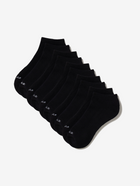Sustainability has taken center stage in fashion, sparking a global shift towards eco-conscious choices.
In this comprehensive fabric breakdown, we delve into the realm of sustainable textiles, where style meets environmental responsibility. From organic cotton's ethical cultivation to Tencel's innovative closed-loop process and the regenerative wonders of hemp and bamboo, each fabric unveils a greener vision for the future.
Join us on this eco-friendly journey as we explore the world of sustainable fabrics and the positive impact they bring to fashion and the planet.
Understanding Sustainable Fabrics
Sustainable fabrics are the eco-warriors of the fashion world, prioritizing harmony between style and the environment. These textiles are crafted with a conscious approach, aiming to minimize their ecological footprint while maximizing fashion's positive impact on the planet.
From organic wonders to regenerated innovations, sustainable fabrics embrace a holistic vision for a greener wardrobe.
By utilizing renewable resources, ethical practices, and mindful production methods, these textiles remind us that dressing stylishly and responsibly can go hand in hand. The fashion industry's shift toward eco-friendly textiles is a positive stride toward a more sustainable and compassionate future.
In contrast, traditional fabrics can sometimes lead to a not-so-stylish environmental and societal burden. Pesticide-laden cotton fields, water-hungry manufacturing processes, and harmful chemical dyes contribute to pollution, biodiversity loss, and even health concerns for workers and wearers alike.
Understanding the impact of these conventional practices underscores the urgency of embracing sustainable fabrics for a brighter fashion landscape.
Organic Cotton
Organic cotton is cultivated using sustainable farming practices that eschew toxic pesticides and genetically modified seeds. Its growth process emphasizes the preservation of biodiversity and nurturing of the soil naturally.
Opting for organic cotton offers numerous advantages over conventional cotton. By avoiding harmful chemicals, it reduces environmental pollution, conserves water, and supports healthier ecosystems. Moreover, its soft texture and hypoallergenic properties make it suitable for sensitive skin.
Organic cotton embodies an ethical ethos, providing fair wages and safe working conditions to farmers. Embracing this eco-friendly fiber also fosters social responsibility, benefiting communities in cotton-growing regions.
Tencel
Tencel, derived from sustainably sourced wood pulp, boasts an innovative closed-loop production method. This eco-friendly process recycles water and solvents, promoting resource efficiency and reducing environmental impact.
Tencel fibers stand out for their eco-friendliness, as they require less water and energy during production compared to conventional fibers. This contributes to a lower carbon footprint and a greener textile choice for conscious consumers.
Tencel fibers are fully biodegradable, ensuring they return to nature without harming the environment. Additionally, the closed-loop production minimizes water consumption, making Tencel a water-conscious alternative to traditional fabrics.
Hemp Fabric
Hemp has a storied past as one of humanity's earliest cultivated fibers for textiles. Dating back thousands of years, its rich history weaves a thread of sustainability through time.
Embracing hemp as a fabric choice offers a myriad of sustainable benefits. It requires minimal water and pesticides to grow, making it a resource-efficient option with a lower environmental impact compared to many traditional fabrics.
Hemp farming acts as a natural ally for the environment. Its deep roots promote soil health and prevent erosion while absorbing significant amounts of carbon dioxide, thereby mitigating greenhouse gases.
Modal
Modal fabric, born from the cellulose of beech trees, boasts a remarkable natural origin. Developed through an eco-friendly manufacturing process, it merges sustainability and luxury in a single textile.
Renowned for its silky smoothness and exceptional breathability, modal fabric offers unparalleled comfort in clothing. Its soft-touch enhances the wearing experience, making it a favored choice for fashion enthusiasts seeking both style and coziness.
Modal's eco-credentials extend beyond its natural origin. Its production process optimizes resource efficiency, including minimal water usage and reduced emissions, earning it a place among eco-conscious textiles.
Bamboo Fabric
Bamboo fabric, derived from the cellulose of bamboo plants, represents an innovative and eco-friendly textile choice. This renewable resource thrives without the need for harmful pesticides or excessive water, making it an environmentally conscious option.
Bamboo fabric offers a plethora of advantages, including its exceptional softness, breathability, and moisture-wicking properties. Its natural antibacterial features and UV resistance add further appeal, making bamboo fabric a sought-after material for sustainable and comfortable clothing.
Choosing Sustainable Fabrics: Considerations for Consumers
Factors to weigh when making sustainable fabric choices
Fiber source
Evaluate the origin of the fabric's raw materials, opting for those derived from renewable and eco-friendly sources like organic crops, sustainably harvested wood, or recycled materials.
Environmental impact:
Assess the fabric's overall environmental footprint, including water and energy consumption, chemical usage, and carbon emissions throughout its life cycle.
Durability and longevity
Prioritize fabrics known for their durability and ability to withstand wear and tear, as longer-lasting garments contribute to reduced waste and a more sustainable wardrobe.
How to identify sustainable fabrics while shopping
Check labels and certifications
Look for eco-friendly certifications or labels indicating sustainable materials like organic cotton, Tencel, or recycled fibers to identify fabrics with a lower environmental impact.
Research brand's sustainability claims
Investigate the brand's commitment to sustainability and ethical practices, ensuring their claims align with reputable standards and transparent sourcing.
Prioritize natural and regenerated fibers
Opt for fabrics derived from renewable resources or innovative regeneration processes, as they often offer eco-friendly alternatives to traditional textiles.
Tips for building a sustainable and conscious wardrobe
Quality over quantity
Invest in high-quality, timeless pieces that withstand trends and daily wear, reducing the need for frequent replacements and curbing fashion waste.
Versatility is key
Choose versatile items that can be mixed and matched to create various outfits, maximizing the use of each garment and minimizing wardrobe excess.
Support sustainable brands
Prioritize brands with a strong commitment to sustainability, ethical practices, and transparent supply chains, encouraging the growth of eco-conscious fashion.
Conscious care
Extend the lifespan of your clothing by following care instructions and utilizing eco-friendly laundering methods, such as cold washing and air drying.
Sustainable Fabric: The Final Verdict
In a world increasingly aware of fashion's environmental impact, sustainable fabrics emerge as the ethical champions of style.
From the timeless elegance of organic cotton to the eco-luxury of Tencel, the regenerative wonders of hemp and bamboo, and the breathability of modal, each fabric stands as a testament to a greener vision for the future of fashion.
Together, we can promote a fashion landscape that embraces both style and environmental responsibility, fostering a more compassionate and sustainable world for generations to come.



